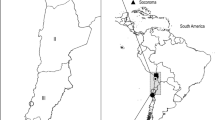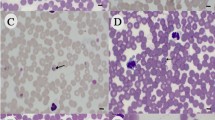Abstract
Background
Enterocytozoon bieneusi, the dominant zoonotic species of microsporidia, has been reported in various animals and humans. However, relatively little information is available concerning the worldwide prevalence and genotypes of E. bieneusi in ruminants, such as sheep and goats. The present study was conducted to evaluate the prevalence and genetic characteristics of E. bieneusi in sheep and goats in east-central China.
Methods
Fresh fecal samples from 832 sheep and 781 goats were evaluated for the presence of E. bieneusi using PCR and sequencing of the ribosomal internal transcribed spacer.
Results
28 sheep specimens (3.4%) and 32 goat specimens (4.1%) were positive for E. bieneusi. A total of 12 ITS genotypes were identified, including 7 known genotypes (COS-I, OEB1, BEB6, CHG1, CHG3, COS-II, and CHC8) and 5 novel genotypes (named AHS1, AHS2, JSS1, AHG1, and AHG2). The dominant genotypes in sheep and goats were BEB6 and CHG3, respectively. Phylogenetic analysis revealed that all genotypes obtained in this study belonged to the so-called “cattle-specific” Group 2.
Conclusions
These findings show a relatively low occurrence and genetic diversity of E. bieneusi in sheep and goats in east-central China. Further studies are required to elucidate the role of sheep and goats in the epidemiology of microsporidia.

Similar content being viewed by others
References
Abu Samra N., Thompson P.N., Jori F., Zhang H., Xiao L. 2012. Enterocytozoon bieneusi at the wildlife/livestock interface of the Kruger National Park, South Africa.Veterinary Parasitology,190, 587-590. https://doi.org/10.1016/j.vetpar.2012.06.031
Al-Herrawy A.Z., Gad M.A. 2016.Microsporidial spores in fecal samples of some domesticated animals living in giza, Egypt. Iranian Journal of Parasitology,11,195-203
Fayer R., Santin M., Trout J.M.2007. Enterocytozoon bieneusi in mature dairy cattle on farms in the eastern United States. Parasitology Research,102,15–20. https://doi.org/10.1007/s00436-007-0746-x
Fiuza V.R., Lopes C.W., Cosendey R.I., de Oliveira F.C., Fayer R., Santín M. 2016.Zoonotic Enterocytozoon bieneusi genotypes found in brazilian sheep. Research in Veterinary Science,107,196-201.https://doi.org/10.1016/j.rvsc.2016.06.006
Huang J., Zhang Z., Yang Y., Wang R., Zhao J., Jian F., Ning C., Zhang L. 2017.New genotypes of Enterocytozoon bieneusi isolated from sika deer and red deer in China. Frontiers in Microbiology,8,879. https://doi.org/10.3389/fmicb.2017.00879
Hu S., Liu Z., Yan F., Zhang Z., Zhang G., Zhang L., Jian F., Zhang S., Ning C., Wang R. 2017. Zoonotic and host-adapted genotypes of Cryptosporidium spp., Giardia duodenalis and Enterocytozoon bieneusi in dairy cattle in Hebei and Tianjin, China. Veterinary Parasitology, 248:68-73. https://doi.org/10.1016/j.vetpar.2017.10.024
Jiang Y., Tao W., Wan Q., Li Q., Yang Y., Lin Y., Zhang S., Li W. 2015. Zoonotic and potentially host-adapted Enterocytozoon bieneusi genotypes in sheep and cattle in Northeast China and an increasing concern about the zoonotic importance of previously considered ruminant-adapted genotypes. Applied and Environmental Microbiology, 81,3326-3335. https://doi.org/10.1128/aem.01928-15
Karim M.R., Dong H., Li T., Yu F., Li D., Zhang L., Li J., Wang R., Li S., Li X., Rume F.I., Ning C. 2015.Predomination and new genotypes of Enterocytozoon bieneusi in captive nonhuman primates in zoos in China: high genetic diversity and zoonotic significance. PLoS One, 10,e0117991.https://doi.org/10.1371/journal.pone.0117991
Keeling P.J., Fast N.M. 2002.Microsporidia: biology and evolution of highly reduced intracellular parasites. Annual Review Microbiology 56:93–116. https://doi.org/10.1146/annurev.micro.56. 012302.160854
Keeling P. 2009. Five questions about microsporidia. PLoS Pathog,5:e1000489. https://doi.org/10.1371/journal.ppat.1000489
Li W., Li Y., Li W., Yang J., Song M., Diao R., Jia H., Lu Y., Zheng J., Zhang X., Xiao L. 2014.Genotypes of Enterocytozoon bieneusi in livestock in China: high prevalence and zoonotic potential. PLoS One. 9,e97623. https://doi.org/10.1371/journal.pone.0097623
Li N., Xiao L.H., Wang L., Zhao S.M., Zhao X.K., Duan L.P., Guo M., Liu L., Feng Y.,2012.Molecular surveillance of Cryptosporidium spp., Giardia duodenalis, and Enterocytozoon bieneusi by genotyping and subtyping parasites in wastewater. PLoS Neglected Tropical Diseases,6,e18099. https://doi.org/10.1371/journal.pntd.0001809
Li W.C., Wang K., Gu Y. 2018. Occurrence of Blastocystis sp. and Pentatrichomonas hominis insheep and goats in China.Parasite & Vectors, 11,93. https://doi.org/10.1186/s13071-018-2671-5
Li W, Song Y, Zhong Z, Huang X, Wang C, Li C, Yang H, Liu H, Ren Z, Lan J, Wu K, Peng G.2017.Population genetics of Enterocytozoon bieneusi in captive giant pandas of China. Parasite & Vectors, 10,499.https://doi.org/10.1186/s13071-017-2459-z
Lores B., del Aguila C., Arias C. 2002. Enterocytozoon bieneusi (microsporidia) in faecal samples from domestic animals from Galicia, Spain. Memórias do Instituto Oswaldo Cruz,97,941–945.
Peng X.Q., Tian G.R., Ren G.J., Yu Z.Q., Lok J.B., Zhang L.X., Wang X.T., Song J.K., Zhao G.H.2016.Infection rate of Giardia duodenalis, Cryptosporidium spp. and Enterocytozoon bieneusi in cashmere, dairy and meat goats in China. Infection,Genetics and Evolution,41,26-31. https://doi.org/10.1016/j.meegid.2016.03.021
Santin M., Fayer R. 2009. Enterocytozoon bieneusi genotype nomenclature based on the internal transcribed spacer sequence: a consensus. The Journal of Eukaryotic Microbiology,l56,34-38. https://doi.org/10.1111/j.1550-7408.2008.00380.x
Santín, M., Fayer, R.2011.Microsporidiosis: Enterocytozoon bieneusi in domesticated and wild animals. Research in Veterinary Science,90, 363–371. https://doi.org/10.1016/j.rvsc.2010.07.014
Shi K., Li M., Wang X., Li J., Karim M.R., Wang R., Zhang L., Jian F., Ning C. 2016. Molecular survey of Enterocytozoon bieneusi in sheep and goats in China. Parasite & Vectors, 9:23.https://doi.org/10.1186/s13071-016-1304-0
Stensvold C.R., Beser J., Ljungstrom B., Troell K., Lebbad M. 2014. Low host-specific Enterocytozoon bieneusi genotype BEB6 is common in Swedish lambs.Veterinary Parasitology,205,371–374.https://doi.org/10.1016/j.vetpar.2014.06.010
Sulaiman I.M., Fayer R., Lal A.A., Trout J.M., Schaefer F.W., Xiao L. 2003.Molecular characterization of microsporidia indicates that wild mammals harbor host-adapted Enterocytozoon spp. as well as human-pathogenic Enterocytozoon bieneusi. Applied and Environmental Microbiology,69,4495–4501. https://doi.org/10.1128/aem.69.8.4495-4501.
Xu H., Jin Y., Wu W., Li P., Wang L., Li N., Feng Y., Xiao L.2016.Genotypes of Cryptosporidium spp.,Enterocytozoon bieneusi and Giardia duodenalis in dogs and cats in Shanghai,China. Parasite & Vectors,9,121. https://doi.org/10.1186/s13071-016-1409-5
Yang Z.Y., ZhaoW., Shen Y.J., Zhang W.Z., Shi Y., Ren G.X., Yang D., Ling H., Yang F.K., Liu A.Q., Cao J.P. 2016.Subtyping of Cryptosporidium cuniculus and genotyping of Enterocytozoon bieneusi in rabbits in two farms in Heilongjiang Province, China. Parasite,23,52.https://doi.org/10.1051/parasite/2016063
Ye J, Xiao L,Wang Y, Guo Y, Roellig DM, Feng Y. 2015.Dominance of Giardia duodenalis assemblage A and Enterocytozoon bieneusi genotype BEB6 in sheep in Inner Mongolia, China. Veterinary Parasitology,210,235-239. https://doi.org/10.1016/j.vetpar.2015.04.011
Zhang Q., Cai J., Li P., Wang L., Guo Y., Li C., Lei M., Feng Y., Xiao L. 2018. Enterocytozoon bieneusi genotypes in Tibetan sheep and yaks.Parasitology Research, 117,721-727. https://doi.org/10.1007/s00436-017-5742-1
Zhang X., Wang Z., Su Y., Liang X., Sun X., Peng S., Lu H., Jiang N., Yin J.,Xiang M., Chen Q. 2011. Identification and genotyping of Enterocytozoon bieneusi in China.Journal of Clinical Microbiology, 49,2006–2008.https://doi.org/10.1128/jcm.00372-11
Zhang Z., Huang J., Karim M.R., Zhao J., Dong H., Ai W., Li F., Zhang L., Wang R.2015. Zoonotic Enterocytozoon bieneusi genotypes in Pere David’s deer (Elaphurus davidianus) in Henan, China. Experimental Parasitology,155,46–48. https://doi.org/10.1016/j.exppara.2015.05.008
Zhao W., Zhang W., Yang D., Zhang L., Wang R., Liu A. 2015.Prevalence of Enterocytozoon bieneusi and genetic diversity of ITS genotypes in sheep and goats in China. Infection,Genetics and Evolution,32,265-70. https://doi.org/10.1016/j.meegid.2015.03.026
Acknowledgements
We would like to thank all of the staff in the sampled sheep and goat farms for their assistance with this study. This study was supported by the Modern Cattle and Goat Industrial Technology System Program of Anhui Province, Anhui Provincial Natural Science Foundation (1808085MC84), the Key Program of Anhui Science and Technology University (No. ZRC2016478) and the Key Discipline Construction Program of University of Science and Technology of Anhui (AKZDXK2015A04).
Author information
Authors and Affiliations
Corresponding author
Additional information
Publisher's Note
Springer Nature remains neutral with regard to jurisdictional claims in published maps and institutional affiliations.
Rights and permissions
About this article
Cite this article
Li, Wc., Wang, K. & Gu, Yf. Detection and Genotyping Study of Enterocytozoon bieneusi in Sheep and Goats in East-central China. Acta Parasit. 64, 44–50 (2019). https://doi.org/10.2478/s11686-018-00006-8
Published:
Issue Date:
DOI: https://doi.org/10.2478/s11686-018-00006-8




